 Employee Communication Best Practices
Employee Communication Best Practices
AI in Internal Communications: 5 Steps to Implement it Efficiently
AI in internal communications is gaining momentum fast. Don’t get left behind. Here’s the info you need plus guidance on the best tools to use.

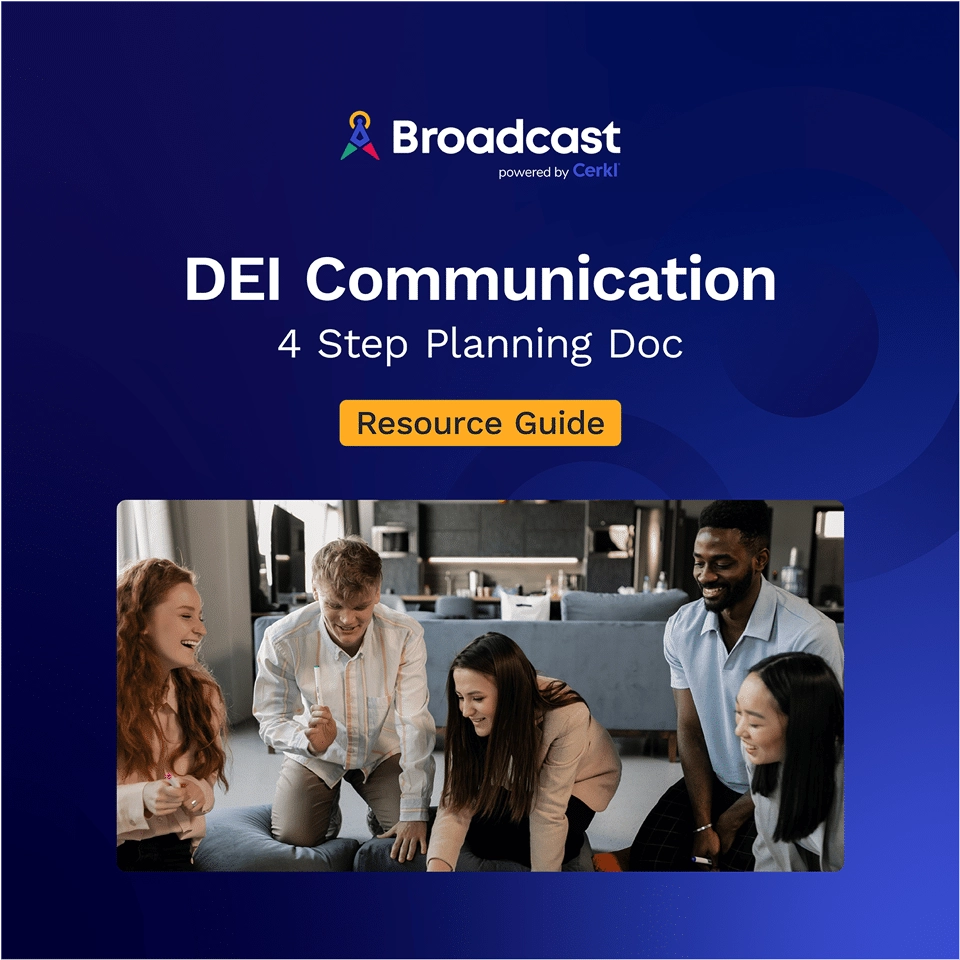
Internal Comms Strategy Template
Start strategizing smarter. Download your free AI-driven internal communications strategy template now!
Access NowKey Findings on AI in Internal Communication
- AI adoption in internal comms remains low. Research shows that AI is still largely untapped in internal communication. Many organizations lack governance or guidance, with many having no frameworks in place to use AI responsibly.
- Internal communicators are well-positioned to lead AI. With strengths in writing and content strategy, internal communicators are natural leaders for AI adoption.
- Personalization potential vs. reality. While AI offers powerful personalization, many lack the tools to deliver targeted content and are unsatisfied with current capabilities.
- AI delivers efficiency gains and engagement benefits. AI can automate repetitive tasks, personalize messaging, and provide real-time data insights, enhancing engagement, reducing workload, and enabling smarter decisions.
- Key challenges remain. Integration with legacy systems, data privacy concerns, and limited training continue to slow AI adoption in internal communication. Artificial intelligence (AI) is revolutionizing various aspects of business, and internal communications are no exception. AI can automate routine tasks, promote personalized messaging, and perform real-time data analytics enabling informed decision-making and efficacy. This fast-developing 21st-century technology is redefining the way organizations communicate internally by enhancing efficiency, productivity, and employee engagement.
However, Gallagher’s 2024/25 State of the Sector survey, Employee Communications Report, reveals that “AI remains untapped, and in-house tech falls short of industry hype.”
“In the consumer world, the use of AI has exploded over the past year, yet it seems that at an organizational level, with the exception of a few market leaders, implementation has been slow. While the revolution may not happen within the next year, an AI-driven market shift is upon us.”
Ben Reynolds, Gallagher, Managing Director, Global Communication Consulting
They ask, Are organizations prepared for AI, and are internal communicators role modelling AI uptake? In response, they found that a key factor is that two in five communicators do not have “governance or guidance” to use AI in place.
Gallagher’s suggestion is for communicators to “Carve an AI niche for comms.” Their research shows that many communicators are taking the lead in promoting the adoption of AI within their organizations. This often involves sharing practical use cases with employees to demonstrate the technology’s value. They believe that prompt engineering — the craft of writing effective prompts to generate desired outputs from AI models — is one area where internal communication methods can truly shine. Since working with large language models (LLMs) doesn’t come easily to everyone, communicators, with their strengths in copywriting and content development, are well positioned to create and maintain a valuable prompt library.
We’re going to focus on what AI is and the astonishing role it can play in improving internal communication.
Definition of AI in Internal Communication
In the diverse field of internal communications, artificial Intelligence or AI is steadily emerging as a major transformative factor. In the context of internal communication, it relates to the use of machine learning, natural language processing (NLP), and advanced algorithms to automate, personalize, and enhance the flow of communication within an organization.
According to Britannica’s definition, the term is commonly used to talk about creating systems that can think like humans, such as being able to reason, find meaning, make generalizations, or learn from past experiences. Internal communications professionals are increasingly leveraging AI to streamline processes and boost employee experience.
“Artificial intelligence (AI), the ability of a digital computer or computer-controlled robot to perform tasks commonly associated with intelligent beings.”
Britannica
However, the concept is growing and changing all the time.
When we talk about AI and its usefulness in internal communications, we refer to a broad range of applications. These include AI writing assistants, generative AI for content creation, AI-driven sentiment analysis, automated campaigns powered by AI prompts, and a whole lot more. The adoption of AI tools in internal comms is not just about enhancing efficiency. It also involves revolutionizing the way content is curated and delivered to bring about elevated levels of employee engagement and satisfaction.
The Role of AI in Internal Communication
Emerging AI technologies are not only changing the digital landscape but also revolutionizing the way internal communicators operate. The ways AI can potentially be leveraged in internal communications are extensive and expansive. They range from automating routine tasks to personalizing content for targeted messaging and enabling real-time data analytics for informed decision-making.
Let’s delve deeper into the notable roles AI currently plays in the broader realm of internal communication.
Automating Routine Tasks
One of the immediate benefits of AI in internal communication is the automation of routine tasks. By applying AI algorithms, much of the repetitive work that internal communicators are traditionally burdened with can be automated. For instance, they can use OpenAI ChatGPT integration to automate the content creation, freeing up time for internal comms professionals to focus on more strategic activities.
However, it doesn’t stop at copywriting and design functionality. Millions of people use OpenAI and other AI-based applications every day, including Google Sheets, Telegram, and YouTrack, simplifying a myriad of more routine tasks.
If you follow Cerkl’s blog posts you’ll know how AI can automate the distribution of communication materials, like email campaigns or social media posts. If you’ve tried it yourself, you’ll know that you will immediately reduce the time wasted on manual postings. This can drastically increase the productivity of your internal communications team, as they can allocate their time and resources better and focus on more strategic tasks.
In the world of internal communication, it is not, as many people mistakenly think, limited to NLP and LLMs.
Personalization and Targeted Messaging
Creating personalized content can boost employee experience significantly. Using AI, internal communications professionals can send relevant emails and messages to employees based on their unique preferences and interaction history, enhancing the overall effectiveness of the messaging strategy. AI-driven personalization tools can also segment the workforce into different personas based on various factors such as role, location, interests, and engagement levels. This seamlessly enables targeted messaging.
Furthermore, AI-driven insights can guide the content curation process, by suggesting content ideas based on employee interaction data. Using machine learning and natural language processing to understand and respond to user inputs makes it possible to craft personalized content at scale. However, as we highlighted earlier, Gallagher points out that a large percentage of internal communicators simply don’t have the right tools to personalize and target messaging.
ML courses can help bridge this gap by equipping communicators with the skills to apply machine learning effectively for personalized, data-driven messaging at scale.
Makes you think, doesn’t it?
What we know is that adding the kind of “mass personalization” that Cerkl Broadcast facilitates makes this a game-changer for employee communication.
Real-time Data Analytics for Informed Decision-Making
Technologies such as AI and machine learning can process complex data at an astonishingly fast rate, providing real-time data analytics. Internal communications professionals gain access to immediate, data-driven insights that can inform and shape their communication strategy.
AI tools can measure the impact of communication efforts, analyze employee feedback, and provide the team with actionable insights.
Whether it’s through analyzing click-through rates of an email campaign or assessing employee sentiment through AI-driven sentiment analysis, these comprehensive insights can help internal communicators work smarter and make data-driven decisions. In the dynamic digital workplace, the ability to leverage AI for real-time analytics has proven to be an invaluable asset for communication platforms.
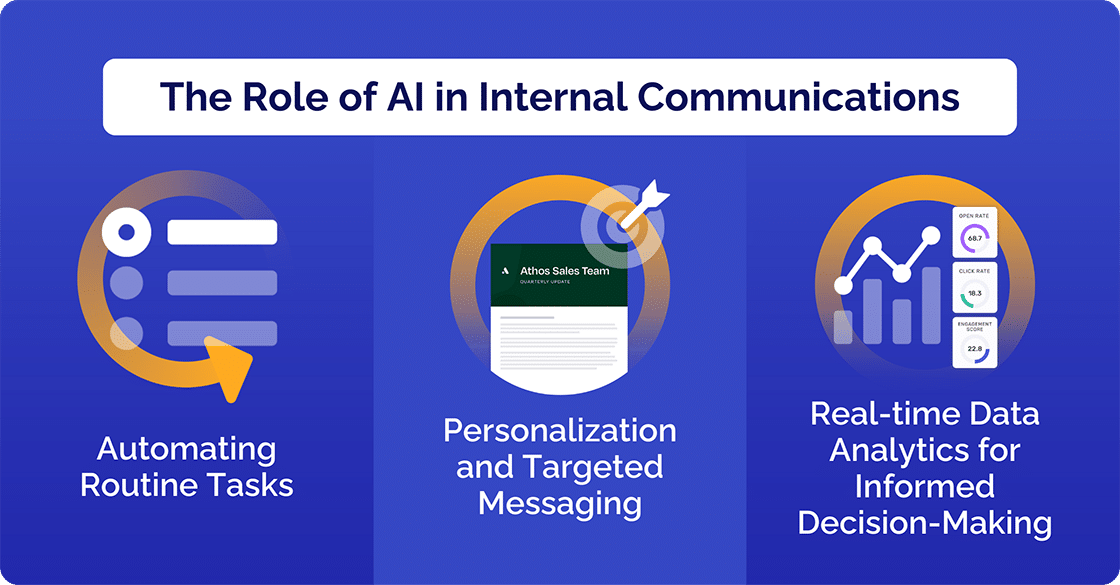
Benefits of AI in Internal Communication
When used effectively, AI can yield significant benefits for organizational internal communications efforts. It can enhance the way internal communicators interact with employees, streamline workflows, and provide actionable insights for decision-making.
Improved Employee Engagement
A major benefit of incorporating AI in internal communication is the ability to improve employee engagement. A digital workplace that utilizes AI tools can deliver more personalized content, helping messages feel relevant and timely. When used strategically, AI writing tools enable communicators to craft targeted messaging tailored to individual needs — leveraging both technology and human insight to foster deeper connections.

AI assistant programs, such as OpenAI’s ChatGPT integration, can improve engagement by facilitating more interactive and relevant communications. They leverage natural language processing for better understanding and accordingly respond to employee feedback and inquiries, adding a personal touch to internal communications. Their ability to process and react to sentiment analysis further helps in addressing employee concerns more effectively and in real-time, thereby boosting the all-important employee experience. Having a ChatGPT cheat sheet can also enhance this by providing quick access to features, making it easier for teams to communicate effectively and respond promptly to employee needs.
Furthermore, AI-driven insights extracted from social media and other employee communications can help identify patterns and trends in employee engagement. Internal communication professionals get a much clearer picture of employee sentiment towards the company, in this way guiding the development of more effective communication strategies.
Enhanced Efficiency and Productivity
AI brings about heightened efficiency and productivity. By automating routine tasks such as content curation and generation, AI tools not only save time for internal communications professionals but also reduce the time typically wasted by employees in endless information searches.
Also, generative AI algorithms can come up with content ideas, draft email campaigns, and even autonomously conduct other more sophisticated tasks like data analysis and reporting. AI can comb through large volumes of data, swiftly generating data-driven decisions and strategies. This feature considerably offsets tedious manual analysis, saving not only time but also enhancing the accuracy of the results.
Generative algorithms may also be capable of understanding and summarizing lengthy documents, research papers, or articles, providing condensed and relevant information for decision-making.
Ultimately, employee communication becomes more efficient, leaving staff with more time to concentrate on more complex responsibilities.
Streamlined Information Flow
AI also facilitates a more streamlined information flow. By capitalizing on machine learning algorithms, AI can determine the most relevant emails and notifications for each employee. This reduces information overload and helps keep employees updated on only the highest-priority matters, along with those that interest individuals, ensuring a smooth information flow.
AI writing bots also contribute to streamlined communications. They can create content for FAQs, internal news updates, and employee recognition posts that can be promptly distributed on digital communication platforms. This removes the need for manual drafting and dissemination, leading to more seamless, more effective internal communication.
Free Internal Communications Strategy Template to Elevate Your Approach
Harness the power of AI to devise a strategy that will be a game-changer for your organization.
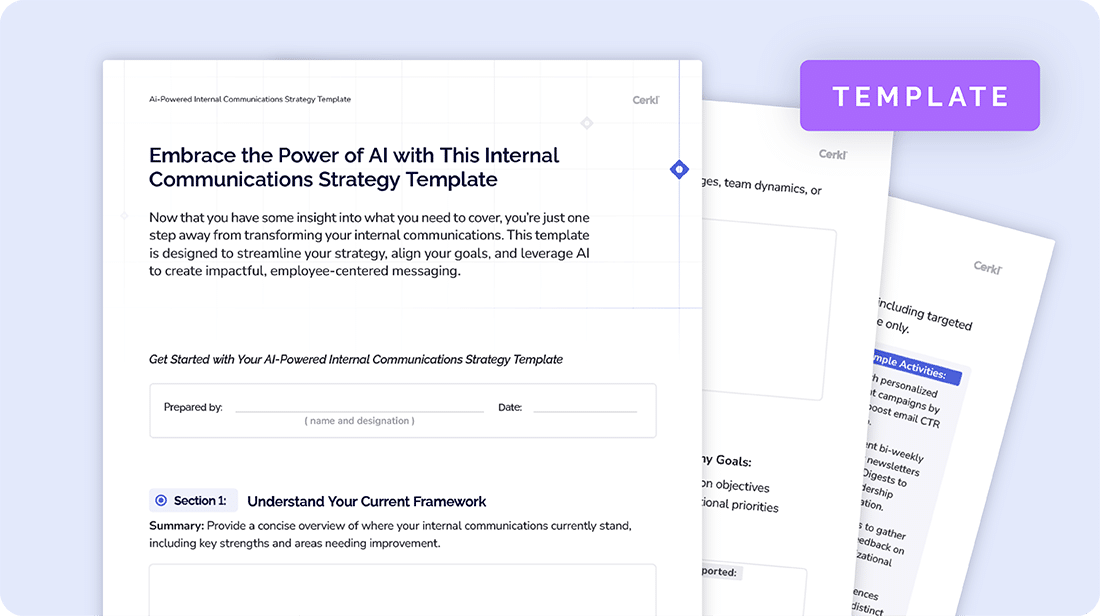
Download Free
Challenges in Implementing AI in Internal Communication
Despite its numerous benefits, the implementation of AI in an internal communication strategy is not without challenges. For instance, businesses embarking on this journey have to deal with critical issues related to data privacy, system integration, and system integration testing, as well as employee training.
Data Privacy and Security
AI’s functionality relies heavily on data collection and analysis, which makes data privacy and security a noteworthy and hugely important concern. As AI systems accumulate and store large quantities of sensitive data, they become susceptible targets for cyber-attacks. Ensuring the secure collection, storage, and processing of this data is crucial for maintaining employee trust and regulatory compliance.
Creating an entirely secure AI system takes time and effort. AI systems need to be regularly updated to guard against the latest security threats — and as you probably know, these change and mutate all the time. This requires ceaseless vigilance from internal communications professionals and IT teams. It also increases the need to maintain and continually update robust cybersecurity measures.
Integration with Existing Systems
Another significant challenge businesses face in AI implementation is its integration with existing systems. Compatibility issues may arise, especially with older or legacy systems not designed to work with advanced AI tools. Even with newer systems, there might be a need for considerable adaptations to ensure seamless communication between AI software and existing technology.
Moreover, companies need to avoid the pitfalls of deploying AI in silos. For effective AI implementation, integrated platforms should be employed that can rationalize all data streams and give a unilateral view to internal communicators.
Employee Adoption and Training
Employee adoption and training constitute another common challenge in AI implementation in internal communications. Resistance from staff who are comfortable with traditional ways of communicating or skeptical about AI could hamper the adoption process.
A recent study by Salesforce found that 38% of UK workers plan to use or are already using generative AI in their jobs. However, 62% say they lack the skills to use these technologies safely and accurately. A large percentage (79%) report that employers don’t provide any type of training. Many are worried about trust and security risks.
Faced with a lack of understanding of AI tools or uncertainty about their job security, employees might resist this technological shift. Overcoming this resistance requires strategic planning, including conducting training sessions and focus groups to familiarize employees with the AI tools and transparently discussing AI’s role in the organization.
Moreover, organizations must instill an understanding that AI is not about job displacement. Rather, it is there to make employees’ jobs easier by removing mundane tasks and allowing more time for creativity and strategic responsibilities.
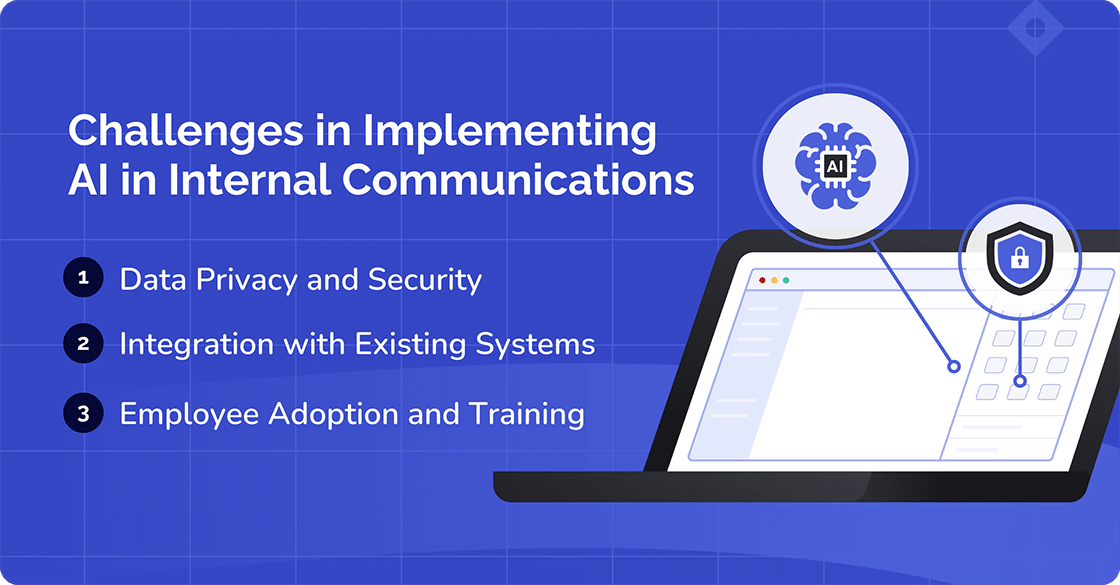
AI Tools to Help You Boost Your Employee Comms
AI is no longer just a buzzword. It’s becoming a powerful partner in internal communication strategies. From surfacing relevant content to anticipating employee needs, AI tools are transforming how organizations connect with their people in meaningful, efficient ways.
AI-Powered News Digests
With so much information flowing through digital workplaces, AI-powered news digests help cut through the noise. Unlike traditional newsletters, these tools automatically curate and summarize relevant updates based on each employee’s preferences, role, and engagement history. Using news digests that are powered by AI is key to making internal content easier to consume and more aligned with what individuals care about.
Predictive Employee Analytics
AI can also help internal communicators look ahead. Predictive analytics tools analyze patterns in employee behavior — like content engagement, survey responses, or platform usage — to identify trends and flag potential issues early. This enables more proactive communication strategies and gives communicators data-backed insights to support leadership decisions. It can make an enormous difference.
Hyper-Personalization
Gallagher’s 2024/25 report highlights the fact that hyper-personalization is increasing in importance. Their 2023/24 report stated that 48% of internal communicators believed this technology would be of high performance in the next five years. However, they discovered in the 2024/25 survey that the foundations are not yet in place. Furthermore, there are low levels of satisfaction around personalization of content (30%) based on HR data, interests, location, role type and level. Nearly half of respondents (49%) admitted they don’t have the right tools for this particular “job” — personalizing content.
Intelligent Content Scheduling
AI in internal communication can also streamline when content is delivered — not just what is sent. Intelligent scheduling tools analyze employee behavior and engagement patterns to determine the best times to push out messages. This helps reduce inbox fatigue, increase open rates, and ensure that key information lands when it’s most likely to be seen and absorbed.
Free Internal Communications Strategy Template to Elevate Your Approach
Harness the power of AI to devise a strategy that will be a game-changer for your organization.

Download Free
5 Steps to Implement AI in Internal Communication
Implementing AI in internal communication facilitates the fast-tracking of mundane tasks, leveraging insightful data for decision-making, and boosting the levels at which employees are engaged. The process requires systematic planning and gradual deployment to ensure successful integration and adoption within an organization’s communication strategy.
Experts in AI and internal communications suggest a number of significant steps for an effective implementation plan. Here are five of the best:
#1 Develop a Strategic Implementation Plan
The first step is to create a thoughtful, realistic, and robust implementation plan. This strategic roadmap should cater to the distinctive needs of your organization. Just be aware that it needs to fully take into account a thorough understanding of the business model, communication requirements, and the core objectives of incorporating AI in internal communication.
It should cover the following elements:
- Identify the primary purpose and desired outcomes of your AI intervention
- Map out specific areas where AI can assist, such as content curation, sentiment analysis, and automation of routine tasks
- Outline the potential challenges and possible mitigation strategies needed
- Put together a timeline for phased implementation
- Break down budget considerations
Determining this detailed plan will help to counteract possible roadblocks, maintain focus, and align the integration of AI tools with company objectives.
#2 Use AI Tools and Platforms
Businesses can leverage AI tools like chatbots or voice over IP solutions for automated customer service and support through natural language processing. AI newsletter platforms like Cerkl Broadcast also tap user data to deliver personalized, targeted content, en masse.
Additional tools include generative AI writing assistants to boost content creation and sentiment analysis to inform communications strategy based on employee feedback. Email platforms further automate customized campaigns.
Chatbots handle inquiries and route issues automatically, while AI newsletters select and distribute custom content to users. Both eliminate (or at the very least minimize) manual work through personalized AI automation.
#3 Ensure Transparency and Communication
Transparency is a critical aspect of AI integration. Internal communicators need to communicate consistently and genuinely regarding AI implementation. This includes providing honest information about the possible implications to confirm how AI will enhance productivity rather than replace humans.
Just like any business activity related to digital workplace adaptation, robust change management principles must be active from the onset. This includes keeping channels of communication open before, during, and after AI integration.
#4 Employee Training and Adoption Strategies
Without proper education and training, employees may have a tough time utilizing AI in internal communication. Therefore, it is crucial to develop a comprehensive training and adoption strategy. Some potential steps include:
- Training internal communicators on how to leverage AI for tasks such as content creation or managing social media platforms
- Conducting interactive workshops to encourage employees to engage with the AI tools in use
- Mentoring sessions with AI experts to clear possible doubts and inspire exploration
- Delivering educational resources such as guides and tutorials to provide support
These strategies will cultivate a competent digital workforce, consequently leading to the required use of AI tools and ultimately to an improvement in internal comms.
#5 Continuous Monitoring and Adaptation
After AI implementation, continuous monitoring is crucial to ensure that these technologies bring the expected benefits and do not create unpredicted setbacks. This includes assessing the effectiveness of AI algorithms, evaluating return on investment (ROI), and tracking improvements in employee experience and engagement.
Adaptation is also crucial following AI integration. It might include refining AI prompts, considering the uniqueness of employee communications, tuning the AI assistant to improve the quality of content creation and content curation, or making changes based on insights drawn from automated campaigns.
These iterative measures feed into a dynamic and evolving AI strategy that continually improves processes, augmenting the power of AI in internal communication.
By adopting these steps, businesses can seamlessly integrate AI into their internal communication strategies, transforming the landscape of their workplace communication and collaboration.

Achieve Successful AI in Internal Communications with Cerkl Broadcast
When Tarek Kamil founded Cerkl Broadcast 16 years ago, his clear-cut mission was to leverage AI to provide an internal communication platform that would embrace multiple channels, provide curated, meaningful content, and enhance the employee experience. This is exactly what it does. As such, Broadcast is a powerful AI tool that will enable you to improve your internal communication strategy.
Broadcast utilizes AI via multiple machine-learning models and neural networks that enable you to deliver real-time, predictive analytics. You’ll be able to engage more effectively with employees by creating targeted, personalized messages. You’ll have access to survey templates that allow you to garner feedback from employees, keeping them permanently in the loop.
The platform allows you to schedule content, and segment your audience. Its omnichannel capability allows them to select their preferred channels so that you effectively streamline communication. It offers enormous benefits for efficient email communication and surveys where you can garner.
Cerkl Broadcast keeps evolving to meet the needs of users. One of the most successful features we have added is automated internal newsletter software, in the form of Broadcast News Digests. Like Broadcast Eblasts, they are truly personalized and employees are able to select preferred interests, delivery times, frequency, and even language.
What’s Next?
Have you assessed the effectiveness of your internal communication strategy? Do you think an AI strategy could help to improve it? Not sure? Why not download our free AI-powered internal communications strategy template? This could be the blueprint for success you have been dreaming of.
It will help you assess your current comms strategy as well as define what you want to achieve and how to get there. Once you have identified the tactics and channels you need to reach your goals, you can get going with a new plan. But how will you know if your new strategy is succeeding? That is covered as well — and a lot more.
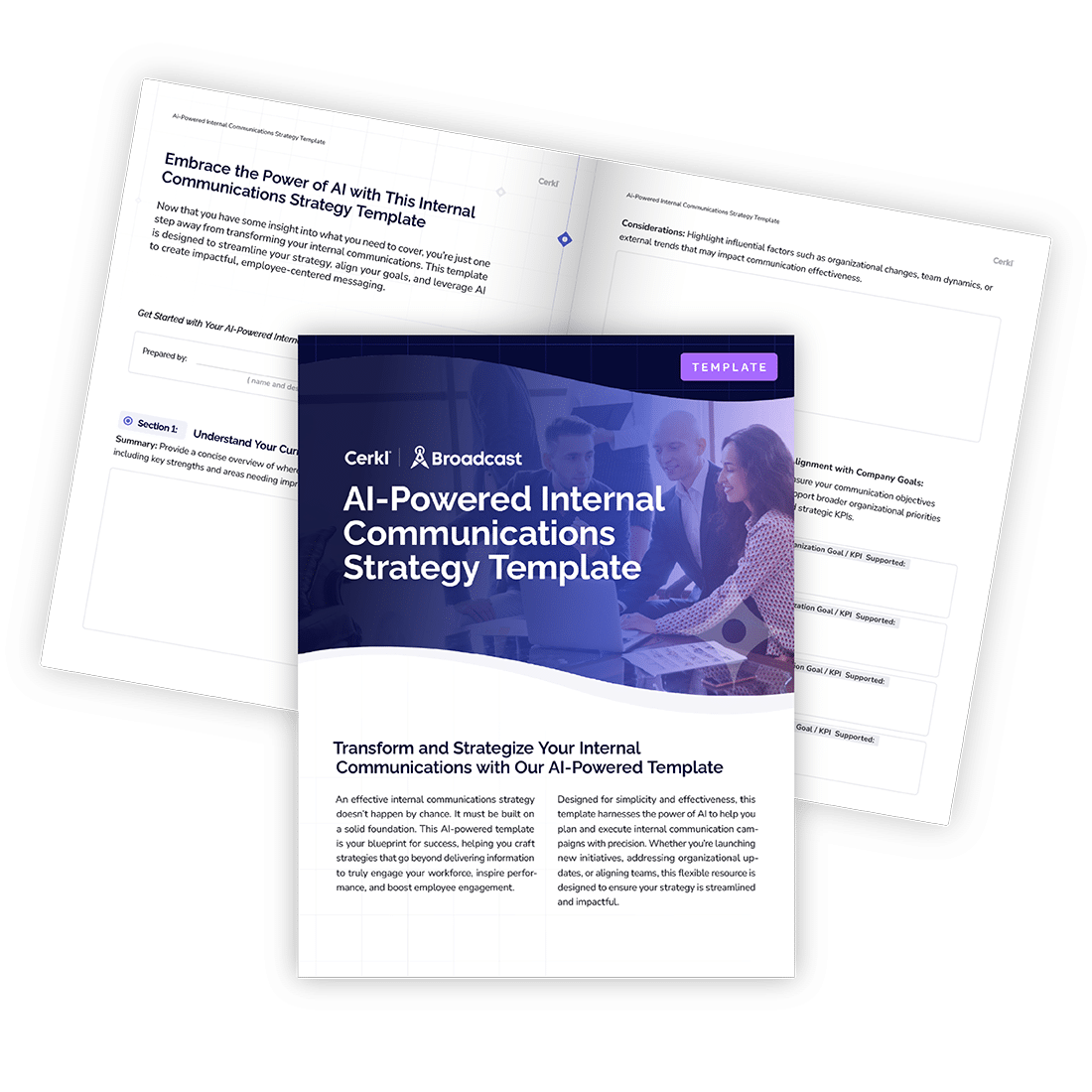
Free Internal Communications Strategy Template to Elevate Your Approach
Harness the power of AI to devise a strategy that will be a game-changer for your organization.
Download Free
FAQ
How is AI used in internal communications? In general terms, AI is used in internal communications to automate routine tasks like scheduling, to provide personalized content recommendations, and to analyze employee sentiment through natural language processing (NLP). The objective is to enhance overall efficiency and engagement.
What is an example of AI in communication? An example of AI in communication is the use of chatbots for internal queries, where employees can interact with virtual assistants to obtain information, request support, or navigate internal systems, improving accessibility and responsiveness.
How can generative AI be used to improve employee communications? Generative AI can improve employee communications by automatically generating personalized and contextually relevant content. This includes tailored emails, newsletters, and reports, saving time for communication teams and ensuring more effective and targeted messaging.
How will AI change corporate communications? AI is expected to change corporate communications in many different ways. This will enable more data-driven decision-making, facilitating real-time analysis of employee feedback. It will also enhance the personalization and efficiency of communication channels, ultimately fostering more effective and engaging interactions within organizations.








